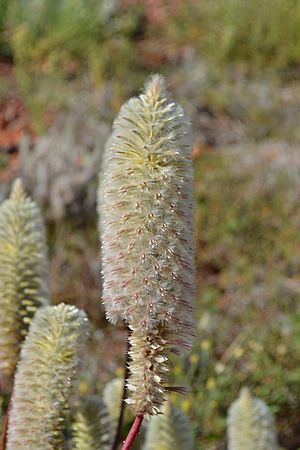Yellow tails facts for kids
Quick facts for kids Yellow tails |
|
|---|---|
 |
|
| Ptilotus nobilis | |
| Scientific classification | |
| Genus: |
Ptilotus
|
| Species: |
nobilis
|
| Synonyms | |
|
|
Ptilotus nobilis, often called yellow tails, is a type of plant that lives for one year (an annual) or a few years (a short-lived perennial). It belongs to the Amaranthaceae family, which includes plants like spinach and amaranth. You can find this plant in dry areas of South Australia, the southern and eastern parts of the Northern Territory, western Queensland, and western New South Wales.
Contents
Discovering Yellow Tails: The Story of Ptilotus nobilis
Who First Described Ptilotus nobilis?
The Ptilotus nobilis plant was first officially described in 1838. An English botanist named John Lindley gave it the name Trichinium nobile. He wrote about it in a book by Thomas Mitchell, which was about his trips into eastern Australia.
How Did the Name Change to Ptilotus?
Later, in 1868, a botanist from Victoria, Ferdinand von Mueller, moved the plant to a different group, or genus, called Ptilotus. This change was published in the sixth volume of his work, Fragmenta Phytographiae Australiae.
Why Do Plant Names Sometimes Change?
Scientists sometimes change plant names as they learn more. For example, in 2007, a study looked closely at the genes of P. nobilis and a similar plant, Ptilotus exaltatus. They found these two plants were very closely related. Because of this, in 2008, some scientists thought they were the same species.
However, a newer study in 2018 looked even more carefully. They found that P. exaltatus and P. nobilis were actually different. They looked at how the plants looked and where they grew. This study helped scientists understand that these plants are indeed separate species. This is how science keeps learning and updating our knowledge!
Where Does Ptilotus nobilis Grow?
Ptilotus nobilis is found scattered across inland New South Wales and other dry parts of Australia. It can grow in many types of soil, but it likes sandy soils more than clay soils. You can often see it in places like:
- Woodlands with Acacia trees
- Mallee areas, which have small, multi-stemmed eucalyptus trees
- Shrublands, which are areas with many bushes
- Grasslands, which are open areas covered in grass
Special Types of Ptilotus nobilis
Scientists at The University of Queensland have worked to create special types of Ptilotus nobilis. These are called cultivars. They have different colors and shapes of flowerheads. Some of these special types include:
- Passion: This type has upright stems and purple flowerheads.
- Poise: This one has flowerheads with two colors, tan and pink.
- Purity: This type also has upright stems, but its flowerheads are green-yellow.
These special types show how diverse and beautiful Ptilotus nobilis can be!

